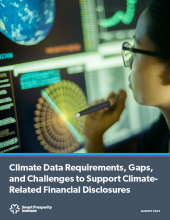Canada has committed to move towards mandatory climate-related financial disclosures across the broader economy in line with the recently issued sustainability standards by the International Sustainability Standards Board. High-quality, transparent, reliable, and comparable climate-related financial disclosures allows businesses to incorporate, quantify and manage climate-related risks and opportunities and in turn allows investors to make better decisions on investments as well as credit and insurance underwriting.
However, data gaps and challenges remain a critical barrier to progress on climate-related financial disclosures and needs to be addressed immediately. Nonetheless, climate data is a cross-cutting issue and there is a need to focus on one application or use case at a time to properly analyze challenges and identify solutions.
Smart Prosperity Institute’s new report “Climate Data Requirements, Gaps, and Challenges to Support Climate-Related Financial Disclosures,” undertaken in conjunction with members of the Sustainable Finance Action Council (SFAC), focuses on the data use-case of climate-related financial disclosures. The report identifies priority climate data requirements, analyzes barriers, and challenges to disclosures and informs ongoing discussions and knowledge mobilizing in addressing this issue.
Based on consultations with SFAC members and analysis of best practices, the report identifies five types of quantitative disclosures that need to be prioritized to support overall climate-related financial disclosures:
- Greenhouse Gas (GHG) Emissions – information, numbers, and methodologies for measurement and reporting of emissions across the value chains (Scope 1, 2 and 3, including financed and insurance-associated emissions).
- Net Zero/GHG Emissions Reduction Targets – information and metrics needed to set net-zero/GHG emissions reduction targets (e.g., interim emissions reduction targets).
- Physical Risks – information, metrics, and analysis to understand business activities or asset’s exposure and vulnerability to physical risks.
- Transition Risks – information, metrics, and analysis to understand business activities or assets exposure and vulnerability to the transition to a net-zero economy, resulting from policy, legal, market, reputation, technological changes, or social adaptation.
- Scenario Analysis – methodologies and forward-looking analysis and results needed to assess physical and transition risks and opportunities.
Main Takeaways for Future Consideration
- Improving data availability across disclosure types: Data to estimate and disclose GHG emissions from direct sources owned and controlled by the organization (Scope 1) and purchase of energy and electricity (Scope 2) seem to be available, but mainly for large companies. There are extensive data challenges around reporting GHG emissions across the value chain (Scope 3, including financed and insurance-associated emissions), transition pathways, and business-relevant inputs for scenario analysis. Data to assess exposure, vulnerability to physical risks, and transition preparedness may not be available, and data availability in these areas must be improved through regular mapping, surveys, and development of methodological guidance.
- Coordinating across stakeholders: To continually fill climate data gaps and address challenges, greater coordination is needed amongst stakeholders such as federal provincial/territorial governments, regulators, standard-setters, statistical agencies/data providers, businesses, industry leaders and financial institutions to provide appropriate guidance, support analytics, and where relevant, conduct regular surveys. Adequate consideration must be given to stakeholders' distinct roles and responsibilities to outline effective coordination.
- Examining data support for small and medium-sized enterprises (SMEs): SMEs may not have access to data or the capacity to analyze data such as GHG emissions and physical risk exposures, which may impede their ability to disclose this information. It may be useful to conduct analysis of the tools & solutions available to support data collection and analysis by SMEs, with adequate considerations for sectoral differences. Efficient, ideally automated, data collection is important to minimize efforts and resources in data collection for financial institutions.
- Analyzing alternate data use cases: As mentioned above, climate-related financial disclosure is one use case and other use cases for financial decision-making may influence data needs such as investment/financial decision making. It may be useful to undertake a use case analysis for Canada’s financial sector that assesses the data needs of different types of financial institutions for different use cases and their availability. This analysis may assist in both the coordinated development of Canada-wide datasets in appropriate areas and allow for a deep-dive into capacity development requirements for companies (both large and small-medium size) and financial institutions to ensure that available data is/can be standardized and decision-useful.



